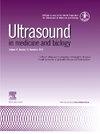Low Intensity Pulsed Ultrasound Activates Excitatory Synaptic Networks in Cultured Hippocampal Neurons
IF 2.4
3区 医学
Q2 ACOUSTICS
引用次数: 0
Abstract
Objective
Ultrasound can noninvasively penetrate deep into the brain for neuromodulation, demonstrating good potential for clinical application. However, the underlying mechanisms are unclear. So far most in vitro studies have focused on the activation of individual neurons by ultrasound with calcium imaging. As the focal region of ultrasound is typically millimeter or submillimeter size, it is important to investigate yet so far unclear how the mechanical effects of ultrasound would influence the synaptic circuit activity of neurons.
Methods
Low-intensity pulse ultrasound was used to stimulate cultured hippocampal neurons. Postsynaptic currents were recorded in individual cells with the whole-cell patch-clamp technique. We also simultaneously imaged intracellular calcium, along with neuronal electrical signals, to resolve neuronal network dynamics during ultrasound stimulation.
Results
Excitatory postsynaptic currents (EPSCs) were evoked by ultrasound in high-density neuronal cultures with increased frequency and amplitude, indicating enhanced glutamatergic synaptic transmission. The probability of evoking responses and the total charge of EPSCs increased with ultrasound intensity. Mechanistic analysis reveals that extracellular calcium influx, action potential firing and synaptic transmission are necessary for the responses to ultrasound in high-density culture. In contrast, EPSCs were not enhanced in low-density culture. Simultaneous calcium imaging of neuronal network activity indicates that recurrent excitatory network activity is recruited during ultrasound stimulation in high-density cultures, which lasts over tens to hundreds of seconds.
Conclusion
Our study provides insights into the mechanisms involved in the response of the brain to ultrasound and illuminates the potential to use ultrasound to regulate synaptic function in neurological disorders.
低强度脉冲超声激活培养海马神经元的兴奋性突触网络。
目的:超声能无创深入脑内进行神经调节,具有良好的临床应用潜力。然而,潜在的机制尚不清楚。到目前为止,大多数体外研究都集中在通过钙成像超声激活单个神经元上。由于超声的焦点区域通常是毫米或亚毫米大小,因此研究超声的机械效应如何影响神经元突触回路的活动是很重要的,但目前还不清楚。方法:采用低强度脉冲超声刺激培养海马神经元。用全细胞膜片钳技术记录单个细胞的突触后电流。我们还同时成像细胞内钙,以及神经元电信号,以解决超声刺激期间的神经网络动力学。结果:超声在高密度神经元培养中诱发兴奋性突触后电流(EPSCs),频率和振幅增加,提示谷氨酸能突触传递增强。引起反应的概率和EPSCs总电荷随超声强度的增加而增加。机制分析表明,细胞外钙内流、动作电位放电和突触传递是高密度培养对超声反应的必要条件。相比之下,EPSCs在低密度培养中没有增强。神经元网络活动的同时钙成像表明,在高密度培养物的超声刺激过程中,反复的兴奋性网络活动被招募,持续数十到数百秒。结论:我们的研究揭示了大脑对超声反应的机制,并阐明了利用超声调节神经系统疾病突触功能的潜力。
本文章由计算机程序翻译,如有差异,请以英文原文为准。
求助全文
约1分钟内获得全文
求助全文
来源期刊
CiteScore
6.20
自引率
6.90%
发文量
325
审稿时长
70 days
期刊介绍:
Ultrasound in Medicine and Biology is the official journal of the World Federation for Ultrasound in Medicine and Biology. The journal publishes original contributions that demonstrate a novel application of an existing ultrasound technology in clinical diagnostic, interventional and therapeutic applications, new and improved clinical techniques, the physics, engineering and technology of ultrasound in medicine and biology, and the interactions between ultrasound and biological systems, including bioeffects. Papers that simply utilize standard diagnostic ultrasound as a measuring tool will be considered out of scope. Extended critical reviews of subjects of contemporary interest in the field are also published, in addition to occasional editorial articles, clinical and technical notes, book reviews, letters to the editor and a calendar of forthcoming meetings. It is the aim of the journal fully to meet the information and publication requirements of the clinicians, scientists, engineers and other professionals who constitute the biomedical ultrasonic community.

 求助内容:
求助内容: 应助结果提醒方式:
应助结果提醒方式:


